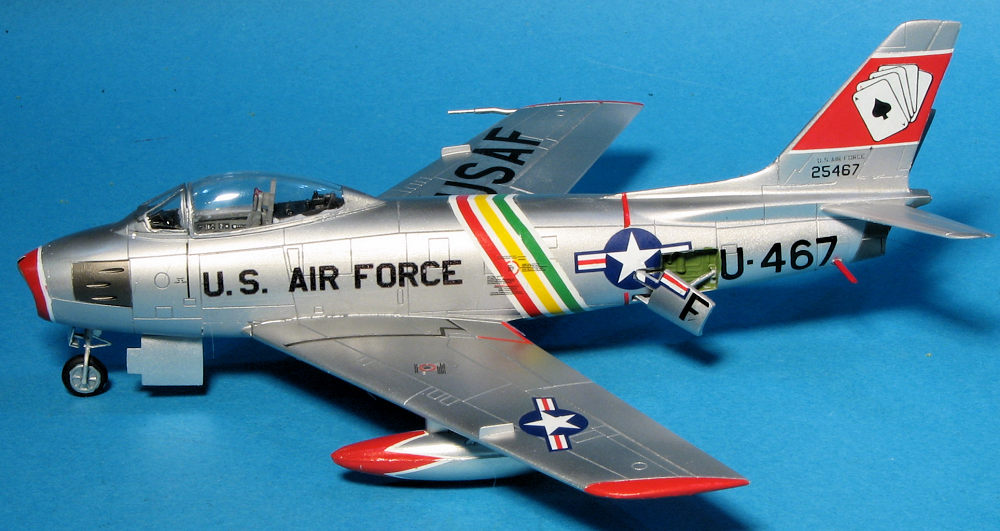
Airfix 1/72 F-86F Sabre
| KIT #: | A03082 |
| PRICE: | $11.75 |
| DECALS: | Two options |
| REVIEWER: | Scott Van Aken |
| NOTES: |

| HISTORY |
Korea was the first major conflict in which jet fighters fought each other in combat. Much has been said about the two protagonists in terms of which was the better aircraft. As with everything when doing comparisons, a few things have to be taken into consideration.
The first is the aircraft themselves. The MiG-15 was not as sophisticated an aircraft as the F-86. It was lighter, had less wing loading and had a more powerful armament. The F-86 was heavier, had superior electronics for the gun sight, and had better armor. The MiG-15 was a better dog-fighting aircraft thanks to its higher thrust to weight ratio and lower wing loading. It was unstable at very high speed. The heavier F-86 was able to dive better, and had a greater weight of fire from its faster firing .50 caliber machine guns than the MiG did with its three, slow firing cannon.
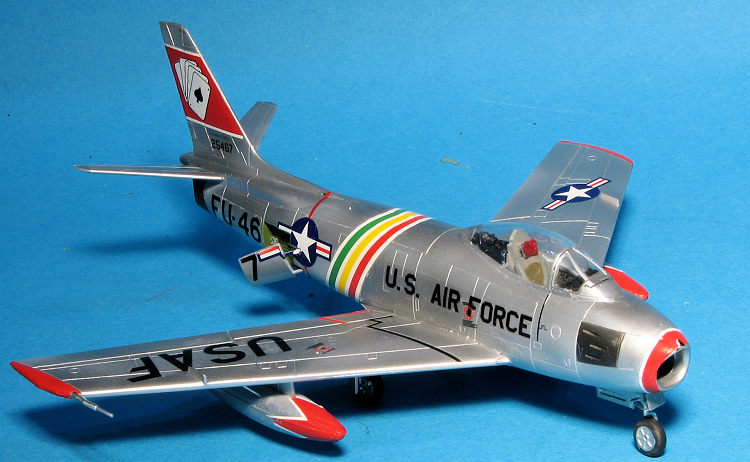 Next is the pilot. The major benefit of F-86 pilots was that they had a G-suit
which kept them from blacking out in dog-fights. The MiG-15 pilot did not have
this and so frequently blacked out during tight maneuvers, often resulting in a
smoking hole in the ground. Secondly, F-86 pilots were brought into units in
small numbers as experienced pilots rotated home. They had better in-country
training and meanwhile experienced pilots were always out on patrol. The MiG-15
pilots, who were basically Soviet, were brought in en masse and so the learning
curve for the unit had to start from scratch every time. This meant that the MiG
pilots were tentative at first and after they had become seasoned, became better
and better until it was time to leave and the cycle started all over again.
Next is the pilot. The major benefit of F-86 pilots was that they had a G-suit
which kept them from blacking out in dog-fights. The MiG-15 pilot did not have
this and so frequently blacked out during tight maneuvers, often resulting in a
smoking hole in the ground. Secondly, F-86 pilots were brought into units in
small numbers as experienced pilots rotated home. They had better in-country
training and meanwhile experienced pilots were always out on patrol. The MiG-15
pilots, who were basically Soviet, were brought in en masse and so the learning
curve for the unit had to start from scratch every time. This meant that the MiG
pilots were tentative at first and after they had become seasoned, became better
and better until it was time to leave and the cycle started all over again.
It also turns out that the kill ration is not as high as initially thought, which to anyone who has followed the subject should not be surprised to learn. So it really means that the aircraft were pretty similar with most giving the airframe edge to the MiG and the pilot edge to the F-86.
| THE KIT |
Molded very much like all of its relatively new kits, the engraving may be a bit much for some, but most of us can deal with it OK. Four standard grey sprues and one clear one for the canopy and windscreen come in the now standard folded cardboard box. This one is made in India so Hornby is still spreading the manufacturing.
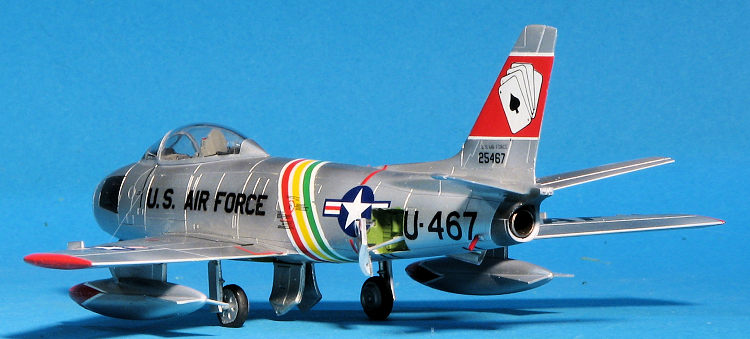 So let us get to the straight Sabre bits. This one has a 6-3 non-slatted wing
with a fence. Sabre people realize that pretty much it is the wing that
determines the accuracy of the markings to be used. Heaven forbid that some one
put slatted wing Sabre markings on a fixed wing F-86. Heads will roll, I tell
you!. The kit has a nice cockpit which includes a pilot figure. No harness on
the bang seat which is pretty much like the real thing, only much simplified.
Decals for instruments, which is OK. An intake section is included with the
upper piece having '3 Grams' engraved on it. Now this means that 3 grams of
weight is needed.
So let us get to the straight Sabre bits. This one has a 6-3 non-slatted wing
with a fence. Sabre people realize that pretty much it is the wing that
determines the accuracy of the markings to be used. Heaven forbid that some one
put slatted wing Sabre markings on a fixed wing F-86. Heads will roll, I tell
you!. The kit has a nice cockpit which includes a pilot figure. No harness on
the bang seat which is pretty much like the real thing, only much simplified.
Decals for instruments, which is OK. An intake section is included with the
upper piece having '3 Grams' engraved on it. Now this means that 3 grams of
weight is needed.
The wing can have pylons added to the inner section for the use of bombs if one
so wishes. Now I'm not sure if the USAF version is the fighter bomber -35 or
not, but in this scale, it probably doesn't matter and those wanting to use the
pylons and bombs will need to do a bit of research if accuracy is important. The
kit has well done landing gear with flattened tires included and two styles of
nose wheel. There are separate 'gear up' gear doors with additional
reinforcement to allow them to be easily installed, a nice touch. The same goes
for the separate speed brakes; a closed option is given. It will be interesting
to see if the molding is such that these
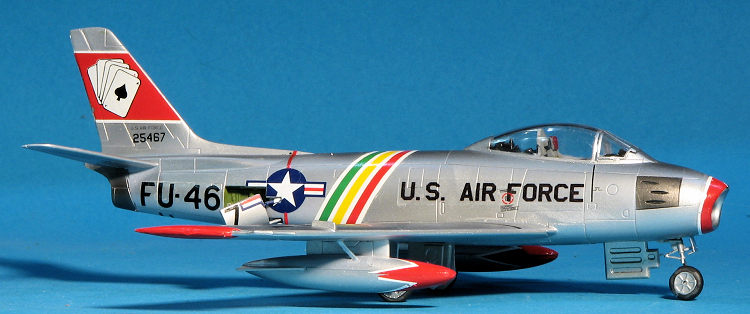 brakes are properly drooped down when
open. In addition to the bombs, the standard early drop tanks are provided for
the outer stations. This is topped by a two piece canopy/windscreen that can be
posed open if one wishes.
brakes are properly drooped down when
open. In addition to the bombs, the standard early drop tanks are provided for
the outer stations. This is topped by a two piece canopy/windscreen that can be
posed open if one wishes.
Kit instructions are well drawn with the usual Humbrol paint numbers in place of real paint names except for the camo and markings guide where the colors used on the outside are identified. Markings are for two planes. One is 'The Huff' as shown on the box art. The other is an Italian plane with the 4th Stormo in 1958. This is in standard NATO colors. This, of course, is the F-86E(M) version or a Sabre 4. Decals are well printed and include not only the Korean War bands but a mass of data markings. I should note that the USAF plane has the correct North American applied curved font.
| CONSTRUCTION |
First thing I did on this one was to cut the wings and drop tanks away from the sprues. This got rid of two sprue frames and provided more space in the box I was using. Did the same with the fuselage halves. I then did some on-the-sprue painting as it is often easier to do than holding tiny pieces when they are painted. Something to keep in mind on Sabres is that the various wells (landing gear and speed brake) were chromate green. The actual doors themselves were unpainted metal on the 'inside'.
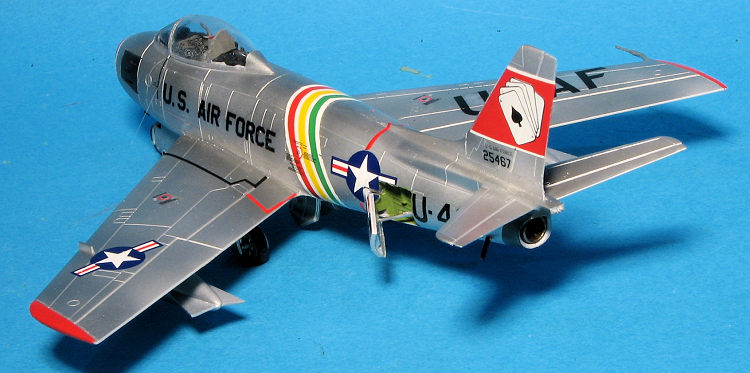 While the paint was drying, I assembled the drop tanks. One of the halves has
a small lip around it and naturally, the sprue gate flows into it. This is
fairly easy to deal with if you have a low speed motor tool. Some careful
grinding will leave this lip intact without gouging the surrounding tank. Also
bear in mind that Airfix plastic is rather soft so it is easy to oversand. Use
the finest grade you have that will get the job done.
While the paint was drying, I assembled the drop tanks. One of the halves has
a small lip around it and naturally, the sprue gate flows into it. This is
fairly easy to deal with if you have a low speed motor tool. Some careful
grinding will leave this lip intact without gouging the surrounding tank. Also
bear in mind that Airfix plastic is rather soft so it is easy to oversand. Use
the finest grade you have that will get the job done.
The intake halves were glued together and after applying the decals to the side consoles of the cockpit tub, that was glued to the intake assembly after putting a small weight in a hollow that is there. The kit seat is little more than a general shape so if you want a more interesting 'pit, get a resin one with a decent seat. I painted the seat head rest red and the 'cushions' with khaki.
After gluing all the bits into the cockpit, I installed it into a fuselage
half. One needs to ensure it is not pushed too far to one side, so temporarily
taping the other fuselage half will assist in this and in getting the tailpipe
assembly properly aligned. When those have dri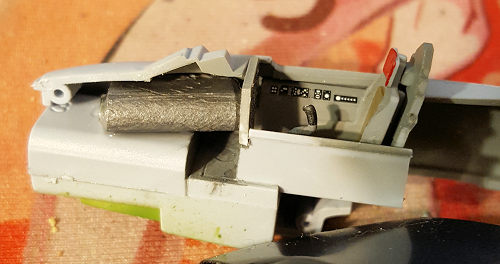 ed,
I cut off a section of lead, folded it, weighed it to make sure it was at least
3 grams, and installed it above the intake. I then trimmed away the little step
on the underside of the exhaust section as it isn't supposed to be there. With
that done, the canopy base piece was slid in place and the halves closed. I also
attached the nose section at this time.
ed,
I cut off a section of lead, folded it, weighed it to make sure it was at least
3 grams, and installed it above the intake. I then trimmed away the little step
on the underside of the exhaust section as it isn't supposed to be there. With
that done, the canopy base piece was slid in place and the halves closed. I also
attached the nose section at this time.
Make sure that you clamp the fuselage well, especially where it meets the fin to eliminate gaps. Though the gaps were pretty well taken care of, there were still some depressions to deal with where the halves meet. I used super glue to fill these. I use this material as it doesn't shrink two weeks after you paint the model as standard fillers will do. It also takes well to being rescribed over without chunking. Downside is that you have to be very careful when sanding it away and it takes multiple applications if the gap/depression is fairly large.
While dealing with the fuselage, I glued the wings together. None of the markings options I'm going to use will have bomb racks installed so I didn't open those. My go to glue, Tamiya extra thin, tends to dry fairly quickly so it was recommended I try a slower drying glue. In this case it is Mr.Cement Deluxe. It smells quite different from Tamiya and does take a bit longer to dry. It also does not have a precision applicator so its brush holds more cement, which is fine for large areas like wings.
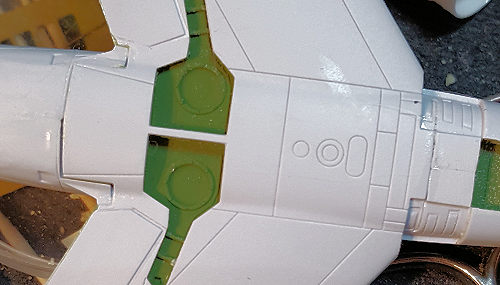 Now it was time to attach the
wings. The fit is very tight and to be honest, not all that great. You need to
test fit multiple times, trimming away a bit to ensure a fairly flush fit. The
right rear section of the wing/fuselage join is where I did the most scraping
and even then there isn't a totally flush fit. This has been something I've
noticed on all the Airfix F-86s I've done so it is not just an isolated case.
You can also see that there are going to be gaps to fill. This sort of fit issue
did not exist in kits where that little fillet was part of the
wings.
Now it was time to attach the
wings. The fit is very tight and to be honest, not all that great. You need to
test fit multiple times, trimming away a bit to ensure a fairly flush fit. The
right rear section of the wing/fuselage join is where I did the most scraping
and even then there isn't a totally flush fit. This has been something I've
noticed on all the Airfix F-86s I've done so it is not just an isolated case.
You can also see that there are going to be gaps to fill. This sort of fit issue
did not exist in kits where that little fillet was part of the
wings.
With all that filled and cleaned, I attached the little ammo bay doors. These do not fit all that snug. Note that the little triangle is not molded on the door like that except for the Flight Systems International Sabres, who did that mod and were probably planes that were used when tooling this kit. I'm not sure just what happens to that little triangle of metal, but I am guessing that it folds back under the ammo doors when they are opened.
That done, the clear bits were next. I masked and then attached them with the canopies closed. I found actually attaching the canopy was a bit of a tight fit. The tail planes were glued on at this time as well. I then cleaned up the landing gear in preparation for painting. Naturally I broke the nose gear when removing it from the sprue. This is a fairly delicate piece and not helped by the soft plastic. I had Scale Aircraft Conversions 72046 metal landing gear so used that. I had forgotten that it also had a metal intake piece to make up for the nose weight so that was saved for a future build. I also filled the gear wells with Silly Putty.
| COLORS & MARKINGS |
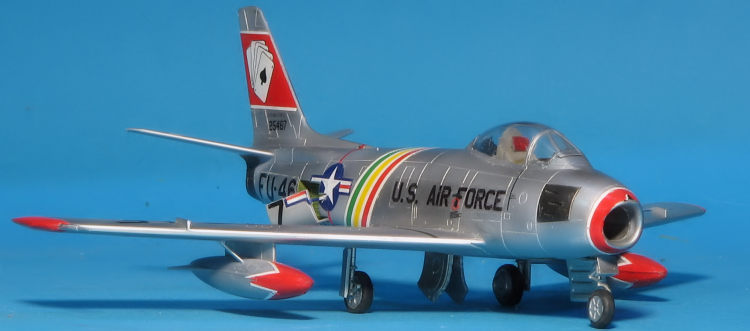 Nice thing about most Sabres is that they are fairly easy to paint. For this
one, I used Alclad II Aluminum overall. Now I know that these planes could
easily be several shades of aluminum but when you look at most images, they seem
to be fairly uniform shades in most light. Besides, it is easier. The exceptions
to this are the gun muzzle panels and the area around the exhaust which were
painted steel.
Nice thing about most Sabres is that they are fairly easy to paint. For this
one, I used Alclad II Aluminum overall. Now I know that these planes could
easily be several shades of aluminum but when you look at most images, they seem
to be fairly uniform shades in most light. Besides, it is easier. The exceptions
to this are the gun muzzle panels and the area around the exhaust which were
painted steel.
For decals, I used Microscale 72-289 that had three colorful F-86Fs. This old sheet was designed for the Hasegawa 1/72 Sabre so I knew there would be issues with the various bands fitting. I chose the wing commander's plane from the 322nd FDG. I first tried out one of the USAF wing decals and as often happens with 40 year old decals, it did not function well. Basically all the clear areas that hold the marking together fell apart and the markings themselves broke easily. I applied two coats of Microscale Decal Film with a brush and that cured the problem for the most part. I still had a few issues with chipping (such as on the right side fuel tank flash).
Since decals at the time did not include the insignia, I used the Airfix kit decals for that and for the wing USAF. The fuselage U.S. AIR FORCE was also not on the sheet and since I did not have the sheet Microscale did for these markings, I printed my own. After several preliminary prints on white paper to get the right size, I printed four of these on clear decal sheet. A coating of Metallizer Sealer to keep the ink from running was all that was needed and these were applied. As expected, the various bands and the tank markings were not a good fit and needed some work to get them to look acceptable.
 Once all the decals were on, I added things like the gear doors and wheels
along with the pitot and fuel dump tubes. Note that the SAC metal nose gear does
not have the groove into which the small nose gear door fits so that ended yp
being a butt join. I had planned on using Pavla's resin wheels for this one, but
they did not show up in time so I used the kit versions. Airfix and a number of other model
companies would have you think that Sabre speed brakes open straight out. This
is not correct and they have a decided droop to them when open. This requires
some cutting on the attachment points to get them at the proper angle.
Once all the decals were on, I added things like the gear doors and wheels
along with the pitot and fuel dump tubes. Note that the SAC metal nose gear does
not have the groove into which the small nose gear door fits so that ended yp
being a butt join. I had planned on using Pavla's resin wheels for this one, but
they did not show up in time so I used the kit versions. Airfix and a number of other model
companies would have you think that Sabre speed brakes open straight out. This
is not correct and they have a decided droop to them when open. This requires
some cutting on the attachment points to get them at the proper angle.
With all that done, a few things were left, like the drop tanks. One has to be somewhat agile to get these along with their small braces in place without making a mess of things. I then did the usual touch up painting and added a few stencil decals so things wouldn't look too bare. The masking was removed and that was it.
| CONCLUSIONS |
This is, I believe the third one of these kits I've built. I've enjoyed every one and they have all had the same issues when it comes to construction. But I really like the F-86 and there will be more in the future, that's for sure. One thing I did find out is that this is a fairly rare kit at this moment. I looked on the net for another to add to the stash for future use and only found some that were stupidly priced on ebay. Perhaps it s time for Airfix to heat up the molds for this one.
8 February 2019
Copyright ModelingMadness.com. All rights reserved.
If you would like your product reviewed fairly and fairly quickly, please contact the editor or see other details in the Note to Contributors.
Back to the Main Page Back to the Review Index Page Back to the Previews Index Page